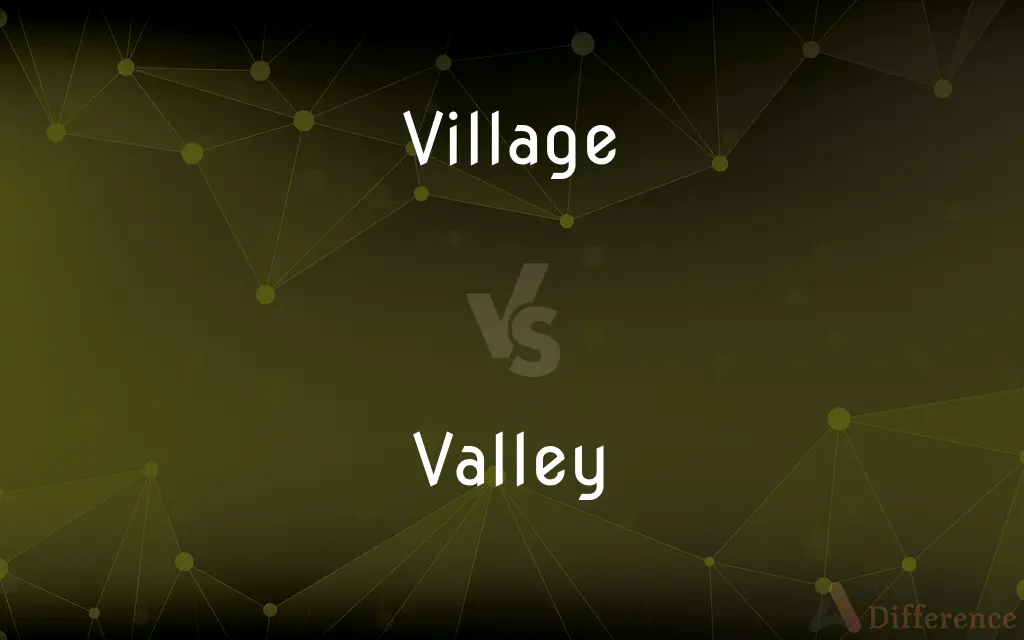Village vs. Valley — What's the Difference?
By Fiza Rafique & Urooj Arif — Updated on March 1, 2024
A village is a small residential community or settlement with a modest population, often rural, while a valley is a geographical feature, a low area between hills or mountains, often with a river running through it.

Difference Between Village and Valley
Table of Contents
ADVERTISEMENT
Key Differences
Villages are characterized by their small size, limited population, and generally rural setting. They are primarily residential areas where people live and may engage in agriculture or other local industries. On the other hand, valleys are natural formations on the Earth's surface, defined by their position lying between hills or mountains.
Villages are considered smaller than towns and cities, both in terms of area and population. They often have a close-knit community with a simple lifestyle and local governance. Valleys are significant for their ecological systems, often housing rivers or streams, and can vary greatly in size, shape, and climate. They are not defined by human settlement, although villages and towns can be located within valleys due to the fertile land and water supply available.
While villages denote human habitation and social organization, valleys are identified by their geographical and topographical characteristics. The presence of a village within a valley is common as valleys offer conducive conditions for farming, shelter, and water resources, which are essential for sustaining human settlements.
The development of villages is influenced by cultural, economic, and social factors, whereas the formation of valleys is a result of geological processes such as erosion and plate tectonics. This difference highlights the distinction between human-made communities and natural land formations.
In terms of functionality, villages serve as living spaces and centers of community life for their inhabitants. Valleys, however, play a role in the natural ecosystem, affecting weather patterns, local climate, and the biodiversity of the area. They can also be significant for human activities such as agriculture, tourism, and hydroelectric power generation, depending on their geographical features.
ADVERTISEMENT
Comparison Chart
Definition
A small, rural residential community or settlement.
A low area between hills or mountains, often containing a river.
Primary Characteristics
Small population, rural setting, local governance.
Natural land formation, lying between higher ground, diverse ecosystems.
Significance
Centers of community life and local industries.
Ecological significance, agricultural potential, and natural beauty.
Formation
Human settlement based on cultural, economic, and social factors.
Geological processes like erosion, glaciation, and tectonic activity.
Usage
Residential, often agricultural or other local industries.
Diverse, including agriculture, tourism, and resource extraction.
Compare with Definitions
Village
Often characterized by farming or local craftsmanship.
Most village residents are involved in agriculture.
Valley
A geographical feature, a low area between hills or mountains.
The valley is renowned for its scenic beauty and lush vegetation.
Village
Reflects a close-knit community lifestyle.
Everyone in the village knows each other and attends the same community hall.
Valley
Often contains a river or stream.
The valley's river provides water for the surrounding farmlands.
Village
A village is a clustered human settlement or community, larger than a hamlet but smaller than a town (although the word is often used to describe both hamlets and smaller towns), with a population typically ranging from a few hundred to a few thousand. Though villages are often located in rural areas, the term urban village is also applied to certain urban neighborhoods.
Valley
Plays a crucial role in the ecosystem and biodiversity.
The valley is home to numerous species of flora and fauna.
Village
A small group of dwellings in a rural area, usually ranking in size between a hamlet and a town.
Valley
Suitable for agriculture and human settlement due to fertile land.
The fertile valley supports a variety of crops and vineyards.
Village
Villages may have historical or cultural significance.
The ancient village has been preserved as a cultural heritage site.
Valley
A valley is an elongated low area often running between hills or mountains, which will typically contain a river or stream running from one end to the other. Most valleys are formed by erosion of the land surface by rivers or streams over a very long period of time.
Village
Serves as a basic unit of settlement in many countries.
The village operates its own local school and market.
Valley
Can be formed through various geological processes.
The glacier-carved valley attracts thousands of tourists yearly.
Village
The inhabitants of a village; villagers.
Valley
A low area of land between hills or mountains, typically with a river or stream flowing through it
The valley floor
The Thames Valley
Village
A small assemblage of houses in the country, less than a town or city.
Valley
An extensive area of land drained or irrigated by a river system.
Village
A community of people smaller than a town
Valley
An internal angle formed by the intersecting planes of a roof, or by the slope of a roof and a wall.
Village
A settlement smaller than a town
Valley
To form the shape of a valley.
Village
A mainly residential district of Manhattan; `the Village' became a home for many writers and artists in the 20th century
Valley
The place of meeting of two slopes of a roof, which have their plates running in different directions, and form on the plan a reëntrant angle.
Village
A small community or group of houses in a rural area, larger than a hamlet but smaller than a town.
The village is known for its annual harvest festival.
Valley
A long depression in the surface of the land that usually contains a river
Common Curiosities
Can a village exist outside of a valley?
Yes, villages can be located in various geographical settings, including plains, coastal areas, and deserts, not just valleys.
Are all valleys suitable for human settlement?
While many valleys offer fertile land and water resources conducive to settlement, not all valleys are suitable due to factors like steep terrain, risk of floods, or extreme climates.
How do valleys affect climate?
Valleys can influence local climate by trapping air, which can lead to cooler temperatures at night and warmer temperatures during the day compared to surrounding higher elevations.
What role do villages play in the economy?
Villages often contribute to the economy through agriculture, handicrafts, local industries, and tourism, depending on their location and resources.
Can valleys be artificially created?
While most valleys are natural formations, human activities like dam construction and mining can create valley-like structures.
What determines the size of a village?
The size of a village is determined by its population, the area it covers, and the availability of land and resources for expansion and sustenance.
Are valleys always formed by rivers?
Not all valleys are formed by rivers; some are created by glacial movement, tectonic activity, or erosion by other means, such as wind.
How are valleys named?
Valleys are usually named after notable geographical features, local flora or fauna, historical events, or nearby water bodies.
Can the definition of a village vary between countries?
Yes, the definition and characteristics of a village can vary significantly between countries and cultures, influenced by local governance, population size, and economic activities.
What is the importance of valleys in history?
Valleys have been crucial for human civilization, offering routes for migration, fertile land for agriculture, and strategic locations for settlements throughout history.
Share Your Discovery

Previous Comparison
Malt vs. Unmalted
Next Comparison
Muesli vs. BircherAuthor Spotlight
Written by
Fiza RafiqueFiza Rafique is a skilled content writer at AskDifference.com, where she meticulously refines and enhances written pieces. Drawing from her vast editorial expertise, Fiza ensures clarity, accuracy, and precision in every article. Passionate about language, she continually seeks to elevate the quality of content for readers worldwide.
Co-written by
Urooj ArifUrooj is a skilled content writer at Ask Difference, known for her exceptional ability to simplify complex topics into engaging and informative content. With a passion for research and a flair for clear, concise writing, she consistently delivers articles that resonate with our diverse audience.














































